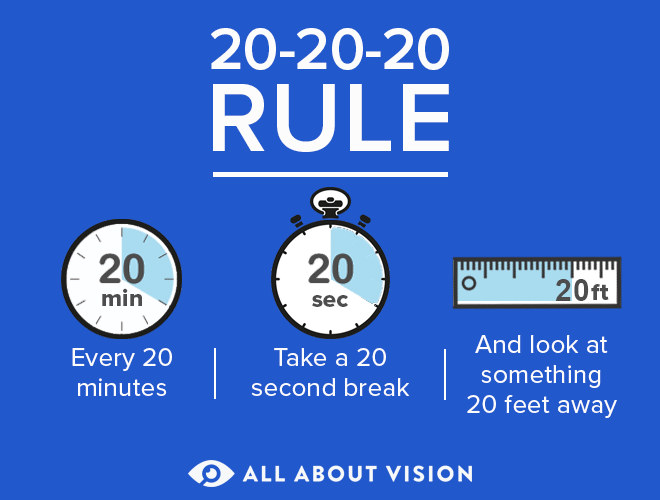The 20-20-20 rule: Strategies for easing eye strain

What is the 20-20-20 rule?
Eye doctors have once again found a way to sneak their favorite number into vision care. Not to be confused with 20/20 vision, the 20-20-20 rule has its own claim to fame. The rule relieves eye strain by reminding you to look at something 20 feet away for 20 seconds every 20 minutes.
Who came up with the 20-20-20 rule?
The 20-20-20 rule did not, regrettably, originate in 2020. It goes back to the 1990s when doctors began to see a significant uptick in eyestrain from digital and near work. Dr. Jeffrey Anshel is credited for coining the phrase.
Increased use of computers, tablets and smartphones in the last few decades has resulted in too many hours of screen time for everyone from toddlers to adults. As a result, an increasing number of Americans are experiencing digital eye strain.
The purpose of the 20-20-20 rule is to remind you to take vision breaks — to look up from the computer screen or your book on a regular basis and give your eyes a little rest.
According to the American Optometric Association, to prevent digital eye strain you should:

Every 20 minutes
Take a 20 second break
By looking at something 20 (or more) feet away
A great way to remember the 20-20-20 rule is to print out this reminder and place it near your computer. Click here to print a 20-20-20 rule handout.
How does the 20-20-20 rule prevent eye strain?
The eye muscles work hard to keep the print on a computer screen clear. It’s not uncommon for long periods of time to pass before someone looks up from a screen. As a result the muscles of the eye become fatigued.
Our eyes are not meant for this type of extended near focus. When the eyes exert this type of effort on a daily basis, computer vision syndrome (also called digital eye strain) can result.
The 20-20-20 rule is a reminder meant to help ease eye strain in people who spend a big portion of the day at work or school staring at a screen. It also works for the rest of us who simply forget to look up when we are browsing online, playing a game or checking our email.
The recommendations in the 20-20-20 rule are based on vision science and optics. Each “20” in the rule has a specific purpose for relieving eye strain.
Why 20 feet away?
In vision science, “optical infinity” is approximately 20 feet. This means that when viewing an object at least 20 feet away, the light rays entering the eyes are parallel to each other. When this is the case, the eye’s accommodation system relaxes.
The accommodation system of the eye adapts to changes in viewing distance so that incoming light rays are properly focused on the retina. This system includes the natural lens of the eye and the ciliary muscle, a circular muscle surrounding the lens.
When looking at a screen monitor — The ciliary muscles contract and the curve of the lens steepens. A steeper lens curvature is needed to focus incoming light rays from your screen onto the retina.
When looking 20+ feet away — The ciliary muscles relax, and the curve of the lens flattens.
A flatter lens curvature is needed to focus incoming light rays from distant objects on the retina.
The ciliary muscles stay contracted the entire time that a near object, such as a computer monitor, is in focus. Taking a break to look at distance allows the ciliary muscles to relax after a sustained period of accommodation.
Other eye muscles, such as the extraocular muscles, which control eye movement, also work to maintain a clear image when you are focused on your screen. These eye muscles have to keep the eyes turned slightly inward, or converged, the entire time.
People also blink less when they are focusing on their monitor for a long time. Blinking is essential for maintaining the eye’s comfort and health. When we take a break and look at the distance, we resume our natural blink pattern, re-establishing the tear film and soothing the eyes.
So, gazing at a distance 20 (or more) feet away allows intermittent rest for eye muscles between periods of accommodation and convergence.
Why every 20 minutes?
The point is to take regular breaks, so if 20 minutes is too often for you to be productive, choose a break time that syncs well with your work rhythm. Although every 20 minutes is optimal, try to take a break at least once or twice each hour. Any vision break is better than none.
Why for 20 seconds?
Just glancing out the window will not give your eye muscles a chance to fully relax. It takes a little bit of time for your ciliary muscles to release their contraction and allow the lens to flatten its curve and see images at distance clearly.
This is why when you have been intently looking at something for a long time, it takes a bit for your vision to clear when you look up.
What’s the 2-hour rule for children (or the 20-20-2 rule)?
Recent studies indicate that spending time outside during the day may actually decrease the risk of myopia, or nearsightedness.
In fact, vision researchers in the Netherlands have added an additional recommendation to the 20-20-20 rule. They recommend that children should be outside for a total of 2 hours a day to minimize risk of developing myopia.
If vision breaks can be taken outside, the research shows that the benefits are even greater. The 20-20-20 rule may be modified to the 20-20-2-hour rule. In addition to taking vision breaks to look at distance every 20 minutes, children should get 2 hours of outdoor time during daylight hours.
What’s the elbow rule?
It’s important not to sit too close to a computer screen or other reading material. To make sure that you or your children are sitting far enough away, the elbow rule can be applied.
The elbow rule ensures that a screen or book is farther than the distance between your hand and elbow. To check, make a fist next to your face and extend your elbow towards what you are reading. This rule applies to all near activities, including arts and crafts!
How about a 20-20-20-20 rule?
If time allows during your 20-20-20 break, stand up stretch and take a random number of steps, like maybe 20?
Researchers have found that sitting for prolonged periods is harmful to your health. Inactivity raises the risk of conditions such as:
Obesity
Metabolic syndrome
Deep-vein thrombosis
Cardiovascular disease
So moving around during your vision break can multiply the benefits of the 20-20-20 rule. Add some chair yoga or 20 jumping jacks to your vision break routine and decrease your risk of multiple diseases — possibly turning it into the 20-20-20-20 rule?
How much screen time do experts recommend?
The American Academy of Child and Adolescent Psychiatry (AACAP) offers the following guidelines for healthy restrictions to daily screen time:
Ages 18 to 24 months — Limit to watching educational programs with caregiver
Ages 2 to 5 years — 1 hour or less on weekdays and up to 3 hours on weekend days
Ages 6+ — Implement healthy habits and routines that limit screen time
SEE RELATED: How to help children avoid computer vision syndrome
Who should follow the 20-20-20 rule?
Everyone can benefit from the 20-20-20 rule. Even fun things such as playing a video game or watching a movie on your laptop can result in eyestrain if you don’t take a visual break.
Symptoms of eye strain may begin during computer work but can continue even after you have finished. If you experience daily strain and do not give your eyes a visual break, symptoms will begin sooner and last longer.
A common sign of eye strain is that symptoms tend to get worse later in the day as you rack up screen time hours. Symptoms of eye strain include:
Pain or pressure, often located in the front of the head
Tiredness
Inability to focus
If you are experiencing these symptoms, it may be that daily screen time without vision breaks has resulted in chronic eye strain. The accommodation and convergence systems of your eye may be exhausted from working overtime.
In fact, your accommodation and convergence are at work right now as you read this article. So, if it’s been more than 20 minutes since you started working at your computer, why not take a look outside and count to 20?
Effects of age on dynamic accommodation. Ergonomics. July 2010.
Convergence insufficiency. StatPearls. July 2021.
Does more screen time put your child’s eyes at risk? Duke Health. September 2020.
Association of time outdoors and patterns of light exposure with myopia in children. British Journal of Ophthalmology. April 2021.
Myopia management in the Netherlands. Ophthalmic and Physiological Optics. March 2020.
Does more screen time put your child’s eyes at risk? Duke Health. September 2020.
The dangers of sitting. Harvard Health. May 2019.
Screen time and children. American Academy of Child and Adolescent Psychiatry. February 2020.
Headache associated with refractive errors: Characteristics and risk factors. Revue Neurologique. October 2020.
Asthenopia. American Academy of Ophthalmology. EyeWiki. August 2021.
Page published on Tuesday, April 26, 2022
Page updated on Tuesday, April 26, 2022







